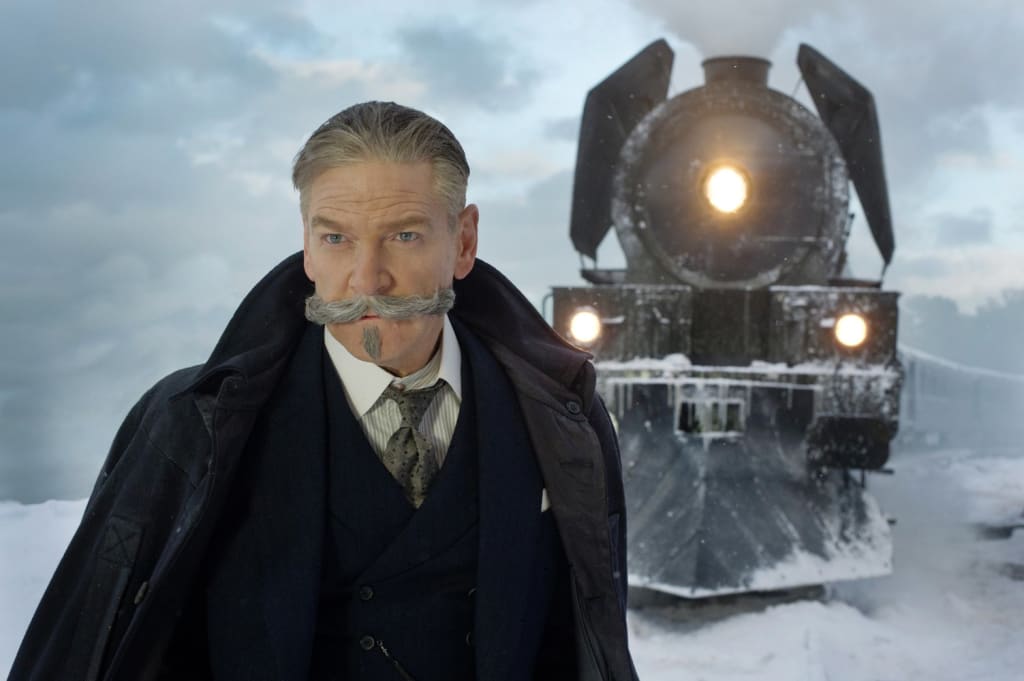Which is Better: 'Murder on the Orient Express' 2017 or 1974?
Branagh takes on Lumet in a cinematic battle.

In a world of reboots, rip-offs and remakes, it can be hard to know which films are worth your time. As such, we put the original and the remake of Murder on the Orient Express face-to-face in a battle for your viewing queue.
The Property

Murder on the Orient Express is a 1934 mystery novel by "queen of crime" Agatha Christie. It is the tenth of her books starring Hercule Poirot, a Belgian super-detective with a magnificent moustache to match. In it, the detective is travelling on the titular train when a gangster named Ratchett is killed. Poirot questions the travellers on the dead man’s compartment, and begins to unveil a conspiracy around a notorious child murder case.
Although the book has made its way onto TV a number of times, most recently in a 2015 mini-series with an all Japanese cast, it has only reached cinemas twice; firstly in 1974, when 12 Angry Men director Sidney Lumet put Albert Finney in the main role on the train with Lauren Bacall, Vanessa Redgrave and Sean Connery, and secondly this year, when Thor director Kenneth Branagh filmed himself as the famous Belgian alongside Daisy Ridley, Michelle Pfeiffer, and Johnny Depp, who gets his comeuppance for at least two Pirates of the Caribbean films too many by being stabbed to death.
Similarities

Aside from any other similarities, both these films share a love of ugly fonts, with the 1974 titles written in a kind of disco remix of Art Deco and the 2017 version using a blue neon font that would look more at home in a Nicolas Winding Refn film.
Aside from this, the two are very much actor’s films. Although Branagh, an acclaimed actor himself, balances his acting scenes with some 70mm-ready landscapes, nearly all of the joy in watching his film comes from watching his stars having a ball with accents, duplicity and characters playing characters. He even gives the characters more backstory to give the actors more to work with, giving for example Derek Jacobi’s butler character an inoperable brain tumour.
Although the performances in the Lumet film are less showy, they too are the centre of his film. This is clear right from the opening titles, with its seemingly endless roll of the era’s biggest stars, and reinforces it as they all meet Poirot in the corridor of a train that is a few flashbulbs away from being a red carpet walk.
He lets his actors have so much to do, in fact, that it nearly derails the film. In the late section after (*BIG SPOILER ALERT*) it is revealed that all of the passengers worked together to kill Ratchett, he gives each actor a line before they plunge the knife in, despite the fact that they’re supposed to be doing this in secret as Poirot sleeps down the hall.
Differences

Despite the general impression of Agatha Christie’s books being all roughly the same mix of aristocrats, military men, butlers, and murderers, Lumet and Branagh manage to make quite different film from the same source material. Some of this can be down to their directorial styles, but most of it can be down to when these films were made. Despite both being adaptations of a book set in the late 30s, they are very much films that reflect their eras.
This is especially true of Branagh’s more recent film. As well as adding some much-needed diversity by changing the race of Arbuthnot (the only black face we get in the ‘74 film is a brief glance of a station porter), the film puts a few anti-racism phrases in Poirot’s mouth that more and more directors are hiding in their films post-Trump. This is not the only way, however, that Branagh’s Poirot belongs in 2017. The character could almost be a Marvel superhero, with superior brain power, wisecracks, and a moustache more ridiculous than even the gimpiest of superhero masks. He even gets an action sequence, a bizarre addition to the film to make it appeal more to the modern movie goer that sees him chasing Josh Gah on the scaffolding under a railway bridge.
Branagh also tries to make his film more visually appealing. Where Lumet seems to have no interest in the views outside of the train, which always look like the drearier passages of the British railway system, Branagh tries to make the snowy wastes around the derailed train a character in themselves. The murder may have been on the Orient Express, but nearly everything else seems to happen outside of it, culminating in a weird "Last Supper" homage as the train inhabitants wait for Poirot to discuss his findings in a railway tunnel. Although these views do improve on the drabness of the original film, they’re still a week part of the film — as we noted in our review, the CGI avalanche looks like a cut scene from the uncanny CGI of The Polar Express.
What Lumet lacks in scenery, however, he makes up for in ratcheting (or the punnier ratchett-ing) up the tension in the train. Branagh’s use of widescreen makes the inside of the train look almost impossibly wide — as a resident of London, most of my flats have been narrower than some of these train carriages. Lumet’s, meanwhile, takes every opportunity to highlight the claustrophobia in the train, with this film having the same feeling of confinement that made the director’s earlier film 12 Angry Men a masterpiece. In his Murder on the Orient Express, characters often have to budge past each other, and are often seen cramped together in corridors or small spaces. He also takes a number of opportunities to use the dark wood of the train to all but block out large portions of the screen, leaving characters in ever-narrowing spaces as Poirot gets closer and closer to the truth of the events on the train.
Which is better?

Both are interesting but flawed films, but for me the 2017 version just inches out the original. Although Lumet’s direction feels stronger, his structure makes for a boring film that goes straight from murder to questioning to a resolution, all without making you care about anyone on screen. Although it is easy to laugh at Branagh’s additions of backstory and action sequences, these do help to break up a story that is essentially "man talks to people in a train." Lumet’s film is like a jigsaw puzzle, with the joy coming from watching the pieces come together. Branagh’s, meanwhile, makes a desperate attempt to be a rollercoaster ride. It doesn’t get anywhere near, but even a poor quality rollercoaster is probably more fun to most than a jigsaw puzzle.
About the Creator
Samuel Spencer
London-based arts and culture writer, specialising in art and film. My work has appeared at ARTINFO, The Culture Trip and HeyUGuys among many others. I love to write about culture in all its forms from Michelangelo to Madonna.






Comments
There are no comments for this story
Be the first to respond and start the conversation.